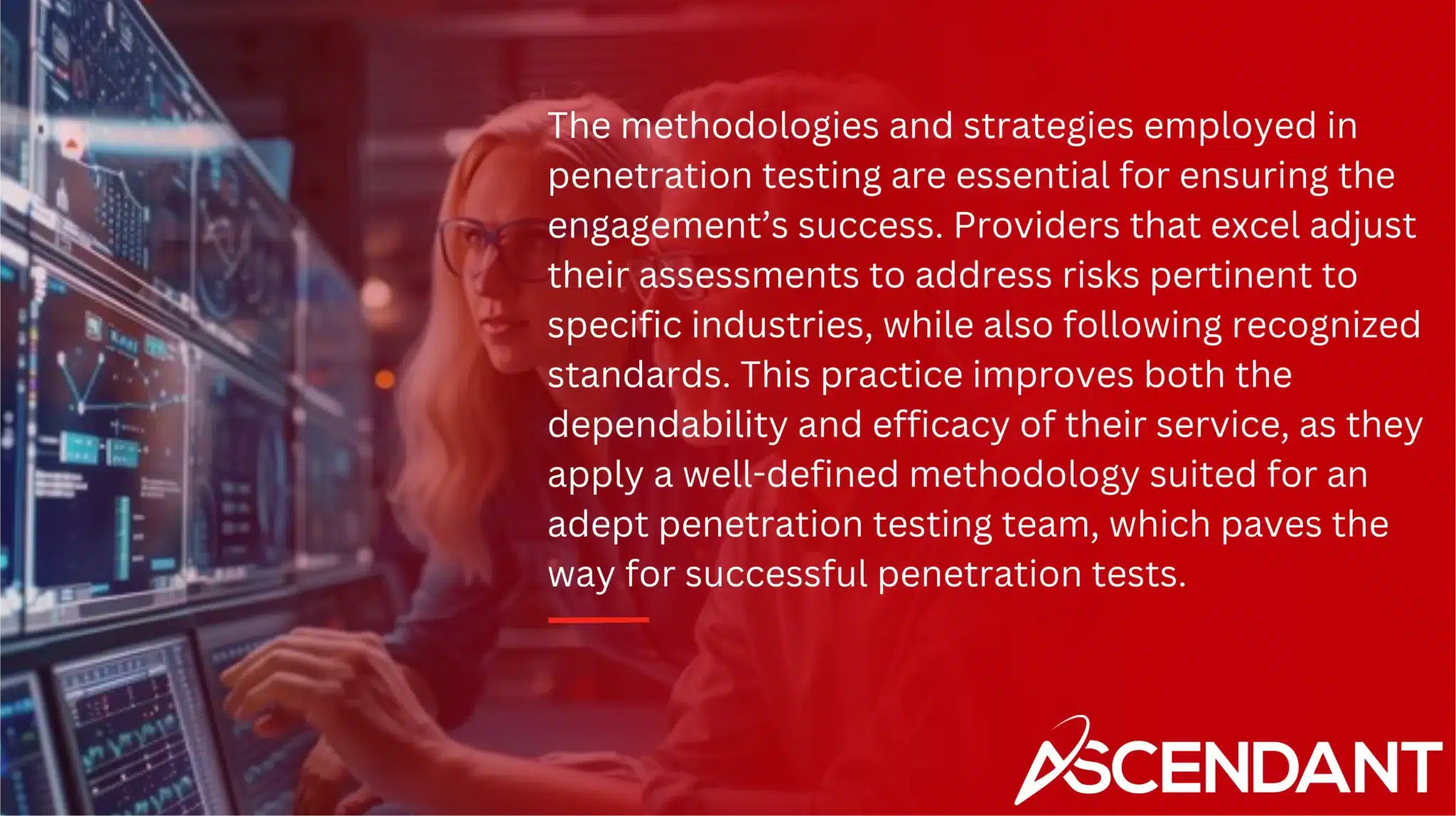Choosing the right penetration testing provider is vital for your security. To understand how to choose the right penetration testing provider, look for expertise, tailored methods, clear reports, and compliance. This article will guide you through these key factors to help you make an informed decision.
In This Article:
- Evaluate Provider Expertise and Credentials
- Assess Testing Methodologies and Approaches
- Review Reporting and Remediation Support
- Consider Data Security and Confidentiality Measures
- Check Compliance and Regulatory Alignment
- Evaluate Communication and Professionalism
- Analyze Cost and Value
- Scalability and Future Needs
- Proven Track Record and Client References
Key Takeaways
- Evaluate penetration testing providers based on expertise, certifications, and industry-specific knowledge to ensure effective vulnerability assessment.
- Assess testing methodologies, including a blend of manual and automated approaches, and choose the appropriate testing type (Black, White, or Grey Box) for your security goals.
- Review detailed reporting, remediation support, and ensure compliance with regulatory standards to effectively address identified vulnerabilities and enhance your overall security posture.
Evaluate Provider Expertise and Credentials
A provider skilled in penetration testing must possess substantial expertise and the right qualifications. The evidence of their proficiency is reflected in a history of successfully pinpointing vulnerabilities while grasping the distinct security hurdles faced by your organization. Holding certifications such as Offensive Security Certified Professional (OSCP) or Certified Ethical Hacker (CEH) underscores the technical skill set of the team, confirming their commitment to operating according to established industry standards.
Having engaged with various sectors, providers gain the versatility required to customize their offensive security strategies, ensuring that they align well with particularized needs related to security and testing within those industries.
Certifications and Experience
Credentials such as OSCP, CEH, and CompTIA PenTest+ serve to demonstrate a provider’s proficiency. They confirm that professionals in penetration testing possess the necessary skills and technical prowess, guaranteeing their familiarity with industry practices and established methodologies. Providers whose staff holds these certifications are expected to offer proficient and impactful services.
Working within diverse sectors offers critical understanding of various security dilemmas and compliance demands. A blend of pertinent qualifications along with broad experience across industries lays a solid groundwork for upholding your organization’s security stance.
Industry Knowledge
Grasping the unique system security challenges within your industry is crucial. Firms such as NVISO and Atredis Partners, which focus on fields including finance, government, and technology, deliver tailored solutions that align with distinct compliance needs and address specific security issues by providing actionable insights.
Having providers versed in sector-specific details allows for a more effective exploitation of systems to uncover pertinent vulnerabilities. This approach substantially bolsters your overall security posture while guaranteeing the safeguarding of sensitive information within those systems.
Assess Testing Methodologies and Approaches

The methodologies and strategies employed in penetration testing are essential for ensuring the engagement’s success. Providers that excel adjust their assessments to address risks pertinent to specific industries, while also following recognized standards. This practice improves both the dependability and efficacy of their service, as they apply a well-defined methodology suited for an adept penetration testing team, which paves the way for successful penetration tests.
Maintaining open lines of communication is vital so that everyone involved has clarity on the scope and goals of the test. It’s important to pinpoint potential hazards early on to guarantee that a safe and comprehensive penetration test is conducted.
Manual vs. Automated Testing
Successful penetration tests incorporate a mix of manual techniques and automated methods. Automated tools are efficient for handling regular tasks and swiftly pinpointing typical vulnerabilities, whereas manual evaluation provides the critical insight necessary to weed out false positives and tackle intricate issues. This combined strategy leverages the rapidity of automated testing with the meticulous scrutiny provided by hands-on assessment.
Companies such as Strobes that utilize both human expertise and automation in their testing process illustrate this potent methodology well. Automation takes charge of monotonous activities, freeing up security experts to concentrate on nuanced vulnerabilities, which guarantees a comprehensive analysis of an organization’s security stance.
Testing Types: Black Box, White Box, Grey Box
Penetration testing encompasses various approaches such as Black-box, White-box, and Grey-box methodologies. In Black-box tests, the scenario replicates an external cyberattack where no insider information is available. This type of test identifies vulnerabilities that an outsider could exploit by using techniques like network penetration testing to reveal how outside threats could breach your system.
Conversely, White-box testing grants full access to the system’s inner workings, which facilitates a thorough exploration of internal weaknesses not visible from the exterior perspective.
By merging insights gained from both inside and out, Grey-box tests offer a balanced evaluation of security threats. They mimic real-world attacks more accurately due to their inclusion of knowledge spanning both realms. Thus enabling a broader detection scope for potential vulnerabilities within systems.
Choosing which form of penetration test best aligns with your organization hinges upon particular security objectives and contextual factors specific to your enterprise.
Review Reporting and Remediation Support
For a penetration testing project to be effective, it is imperative that it includes thorough reporting and assistance with remediation. The reports must outline the discovered vulnerabilities, rate their criticality, and provide recommendations for corrective actions that can function as a tactical roadmap for leadership and technical staff alike.
Support following the test plays an integral role in properly tackling the found vulnerabilities and progressively improving your security posture. This entails offering help with fixing these issues to ensure they are adequately resolved.
Detailed Reports
A meticulously prepared penetration test report is essential for steering your security strategies. It’s designed to encapsulate the findings in an executive summary while offering comprehensive technical data that engineers require. To aid those without a technical background in grasping the gravity and variety of vulnerabilities, visuals such as graphs and charts are instrumental. Notably, these reports shine a spotlight on critical vulnerabilities and their potential impacts, thereby assisting teams with setting priorities for their remediation work.
Included within this document should be a straightforward plan aimed at confronting identified weaknesses. It needs to present stepwise advice along with visual captures—screenshots—wherever they’re needed. By providing these actionable insights, the team can more effectively neutralize threats and enhance the overall robustness of the organization’s security posture.
Remediation Assistance
It is crucial to have robust remediation support in place. Service providers commonly deliver continuous advisory assistance, aiding organizations in tackling identified security weaknesses. Adopting this forward-thinking strategy guarantees that the actions taken for remedy are consistent with the demands of regulatory compliance. Conducting follow-up retests after remediation affirms the successful mitigation of vulnerabilities previously uncovered.
The act of retesting plays a critical role as it offers confirmation that issues have been properly resolved and there has been an enhancement to your organization’s defense mechanisms. Penetration testing holds its worth through its capacity to detect and resolve security gaps throughout the pentesting procedure, thereby averting substantial economic repercussions associated with data compromises.
Consider Data Security and Confidentiality Measures
During penetration testing, it is crucial to prioritize the security and confidentiality of data. Penetration testing providers are required to adhere to rigorous measures that protect sensitive information, which includes complying with data protection legislation, upholding privacy, and fortifying network security.
Adherence to stringent data safeguarding protocols and compliance with regulatory standards consolidates trust from clients by guaranteeing the safety of their sensitive information.
Data Protection Practices
Practices for protecting data are crucial. Utilizing encryption is vital when it comes to the storage and transfer of sensitive information, while rigorous access restrictions make certain that only those with authorization can access or manage this data. This synergy upholds the security of the data throughout penetration testing as well as afterward.
Strong measures for the protection of data guarantee that confidential information stays protected and secure during involvement, thus preserving the wholesomeness of the process involved in penetration testing.
Incident Response Plan
Having a clear and thorough incident response plan is vital for dealing with data breaches that may occur during penetration testing. This plan needs to define procedures for prompt and efficient action. By simulating real-world attacks, it’s possible to uncover potential weaknesses ahead of time, thus reducing the severity of any actual security incidents and preserving your organization’s security stance.
An effective incident response strategy reflects a provider’s dedication to responsible ethical hacking practices as well as adherence to rigorous security protocols. It offers assurance that they are equipped to manage unforeseen events adeptly, thereby safeguarding your organization from likely cyber threats.
Check Compliance and Regulatory Alignment
Adherence to regulatory standards is crucial for maintaining the integrity and legality of penetration testing services. It is imperative that providers are well-versed in mandates such as PCI DSS, GDPR, and HIPAA to guarantee their methods comply with legal norms. Selecting a service provider proficient in these regulations is vital for achieving compliance and circumventing potential fines.
Maintaining professional conduct throughout the duration of engagement necessitates strict observance of ethical codes and legal obligations associated with penetration testing services.
Regulatory Requirements
It is essential for providers to have a grasp of particular regulatory frameworks such as PCI DSS, GDPR, and HIPAA in order to maintain compliance. Recognizing these stipulations aids providers in conforming their testing procedures with the relevant legislation and steering clear of penalties.
Opting for a provider proficient in these regulations assists your organization not only in fulfilling legal mandates, but also boosts its security posture. This expertise guarantees that security protocols are both efficient and adhere to established industry standards.
Industry Standards
Sticking to recognized industry best practices not only bolsters security but also signals a strong commitment to maintaining a resilient security stance. By conforming to these benchmarks, the reliability and efficacy of testing methods are ensured, taking into account prevalent vulnerabilities and specific security requirements. Such adherence showcases the provider’s dedication to advanced technical capabilities and excellence in the realm of security.
When service providers observe industry norms, they’re more capable of providing superior quality testing services. Employing established best practices allows them to conduct thorough evaluations that spot potential risks and weaknesses. This strategy guarantees that your organization’s protective strategies remain up-to-date and robust against the continuously changing landscape of cyber threats.
Evaluate Communication and Professionalism
During penetration testing, it’s essential for the provider and client to engage in clear communication to collaborate without hindrance. Keeping the client regularly informed aids in better project oversight and ensures that their expectations are met.

Choosing a reliable partner for penetration testing is crucial as they will tailor their services to cater directly to your unique requirements while providing continuous support. The way in which this partner communicates professionally demonstrates a respect for the client’s needs, thereby improving the quality of interaction throughout the engagement.
Clear Communication
Ensuring transparency and seamless cooperation throughout a penetration test is crucial, which can be achieved through clear communication. By regularly providing updates on the initiation and completion times, scope of testing, essential discoveries, and any challenges faced during the process helps to synchronize expectations and cultivate a stronger partnership.
Selecting an appropriate partner who prioritizes transparent dialogue guarantees that vital information is conveyed quickly and precisely. Such openness contributes to better-informed decision-making and adeptly tackles security concerns as they arise in the course of testing.
Professional Conduct
Maintaining a professional demeanor in the realm of penetration testing is crucial for fostering trust and facilitating productive cooperation. It is essential that providers pay careful attention to the requirements of their clients, and they should provide testimonials from past clients as evidence of their dependability. A swift turnaround time when conducting security assessments showcases both professionalism and flexibility within the testing procedures.
By observing industry best practices and upholding a professional standard, providers of penetration testing are able to offer services of superior quality. Such dedication not only bolsters your organization’s security, but also lays down a robust groundwork for an enduring collaborative relationship.
Analyze Cost and Value
Evaluating the expenses associated with penetration testing services is crucial for adhering to budget constraints and allocating resources appropriately. Ensuring that the quality of service justifies the cost is key in effectively identifying and mitigating vulnerabilities, thereby enhancing organizational security.
It’s important to comprehend how a provider structures their pricing, taking into account potential extra charges for follow-up retests or prolonged support, which will aid in making an educated choice regarding penetration testing services.
Pricing Structure
The cost of penetration testing is often calculated using various pricing strategies, such as hourly rates that span from $200 to $300, fees for the entire project, agreements involving retainers, and value-based models which assess costs according to the effectiveness of the provided services. Penetration testing vendors typically adhere to a standard pricing framework based on predetermined scopes that might involve both set charges and hourly billing contingent upon how complex the required tests are. Speaking, the price tag for penetration tests hovers in the lower tens-of-thousands range with numerous offerings available under $20,000.
There’s considerable variability in what different types of penetration tests may cost. Web application assessments can be priced between $5,000 and $30,000 while internal network examinations tend to command higher prices due to their increased intricacy and breadth.
Several elements influence how much one will spend on pen-testing efforts. These include but aren’t limited to: The extent of coverage intended by a test, qualifications held by testers conducting it, and how long they’re engaged in assessing systems. Plus any supplementary options like ongoing assistance post-remediation.
Value Proposition
The value of penetration testing, or pen testing, is gauged by weighing the expense incurred from conducting these tests against the potential financial losses due to undiscovered security flaws. It’s crucial for companies to allocate funds for penetration testing as it offers a clear picture of their current security posture by pinpointing exploitable weaknesses that could be targets for malicious entities. The assessment of how cost-effective penetration testing services are includes an analysis comparing their cost with the anticipated diminution in risks and exposure to vulnerabilities.
Penetration testing services play an indispensable role within an organization’s defense strategy by delivering insights that can be acted upon and critical data regarding its security measures. These investments in pen-testing provide long-term savings by averting incidents such as data breaches, which can lead to steep economic costs and damage reputation extensively.
Scalability and Future Needs
An organization’s expanding security requirements necessitate scalable services from a penetration testing company, ensuring that as the entity grows, their security needs are met with adaptable and flexible testing capabilities. The evolution of penetration testing is pivotal for providers to accommodate these dynamic security demands.
Consistent communication through regular updates throughout the course of a penetration test fosters strong trust between the client and the penetration testing provider.
Service Scalability
Adaptive penetration testing services are essential for adjusting and scaling up the capabilities of testing to match a growing organization’s changing security requirements. As an organization enhances its security stance, it is imperative that service providers facilitate more frequent testing while maintaining comprehensive examination depth. Models like penetration testing as a service (PTaaS) allow for consistent vulnerability analysis, thus improving cost-efficiency and strengthening the overall security posture against complex threats like advanced persistent threats.
The ability to scale is vital for penetration testing services in response to the dynamic security demands of expanding organizations. It’s important for service providers to offer versatile testing options that keep pace with emerging technologies, adapt seamlessly into cloud-based platforms, and secure web applications effectively. This level of flexibility guarantees robust protection and ensures sustained security resilience as your organization grows and transforms.
Long-Term Partnership
Entering into a sustained partnership with a penetration testing provider can greatly strengthen your organization’s defense against security threats. Such providers should be capable of scaling their testing efforts in line with the increasing needs of the organization, thereby ensuring continuous and adaptable security measures are in place. This ongoing relationship guarantees that your specific security requirements are reliably satisfied and any emerging vulnerabilities are dealt with preemptively.
Opting for a penetration testing vendor known for its extensive experience and skilled team positions your organization to better shield itself from contemporary cyber dangers. A durable alliance not only cultivates mutual trust, but also paves the way for more effective protective tactics, culminating in an enhanced overall safeguarding stance for your enterprise.
Proven Track Record and Client References
When selecting a professional penetration testing vendor, it is essential to verify their legitimacy by asking for references from previous customers. To evaluate the dependability and efficacy of a penetration testing provider, you should inquire about sample reports and past client testimonials before coming to a conclusion. Opting for a vendor with an established history of successful outcomes will likely lead to a more effective and influential security test.
The reputation of a penetration testing provider can be bolstered by various factors such as their history in publishing security research, the expertise of their personnel, and their standing within the industry. These elements are indicative of the provider’s credibility in conducting thorough and reliable tests.
Client Testimonials
Client endorsements serve as a key indicator of the contentment and effectiveness experienced by users of a penetration testing provider’s services. Examining these testimonials can provide prospective clients with an understanding of the provider’s proficiency in achieving desirable results. Indeed, client feedback and case studies play an essential role in enabling well-informed choices when it comes to selecting a vendor for penetration testing.
The association of esteemed clientele like Reebok, Bitcoin.com, Airalo, and Hello Fresh with renowned providers speaks volumes about their consistent performance history and dependability. Such commendations demonstrate the provider’s commitment to delivering top-tier testing services that align with industry best practices and display robust technical capabilities.
Proven Success
Clients such as Amazon, Zoom, Sonos, and John Deere have relied on the penetration testing services provided by Bishop Fox, underscoring their dependability and proficiency in uncovering security weaknesses. Globally recognized enterprises trust IOActive for its established reputation in pinpointing vulnerabilities and bolstering overall security defenses.
It’s imperative to choose a penetration testing provider with a documented history of success to effectively detect potential risks within your organization’s network infrastructure while reinforcing its safeguard mechanisms. Engaging a reputable provider ensures that your company receives practical recommendations alongside crucial data necessary for reducing threats and strengthening protection measures.
Opting for an experienced service provider guarantees peace of mind through high-caliber testing performance tailored to cater to the unique protective requirements of your enterprise. Such proven competence affirms confidence that the delivered services will thoroughly address your organization’s particular cybersecurity demands.
 Summary
Summary
In conclusion, choosing the right penetration testing provider involves evaluating their expertise, methodologies, reporting capabilities, data security measures, compliance with regulatory standards, communication practices, cost-effectiveness, scalability, and track record. By carefully considering these factors, you can select a provider that aligns with your specific security needs and enhances your organization’s overall security posture. Remember, the right partner will not only identify vulnerabilities but also provide actionable insights and support to mitigate risks effectively. Invest in a provider who offers a long-term partnership and proven success to ensure your organization’s security is always a top priority.
Frequently Asked Questions
Why are certifications important when choosing a penetration testing provider?
Certifications such as OSCP and CEH are crucial when selecting a penetration testing provider because they validate the skills and expertise of the professionals, ensuring the delivery of high-quality and effective testing services.
This assurance of competency is vital for safeguarding your organization’s security.
What is the difference between manual and automated testing?
The key difference between manual and automated testing is that manual testing relies on human analysis for complex vulnerabilities, while automated testing employs tools to efficiently detect common issues.
Utilizing both methods provides a thorough evaluation of the system’s security.
How can client testimonials help in choosing a penetration testing provider?
Testimonials from clients provide crucial evidence of a provider’s dependability and efficiency, highlighting their track record of success and the level of contentment among their customers.
Such endorsements are greatly beneficial when it comes to selecting a trustworthy penetration testing provider with informed confidence.
Why is it important for a provider to understand industry-specific regulatory requirements?
It is crucial for a provider to understand industry-specific regulatory requirements to ensure compliance with legal standards such as PCI DSS, GDPR, and HIPAA. This alignment not only protects the organization from potential legal issues, but also instills trust with clients and stakeholders.
What should a comprehensive penetration test report include?
A comprehensive penetration test report should include a summary for executives, detailed technical information for engineers, visual representations, a list of critical vulnerabilities, and clear remediation steps.
This ensures that all stakeholders can understand the findings and take appropriate actions.

